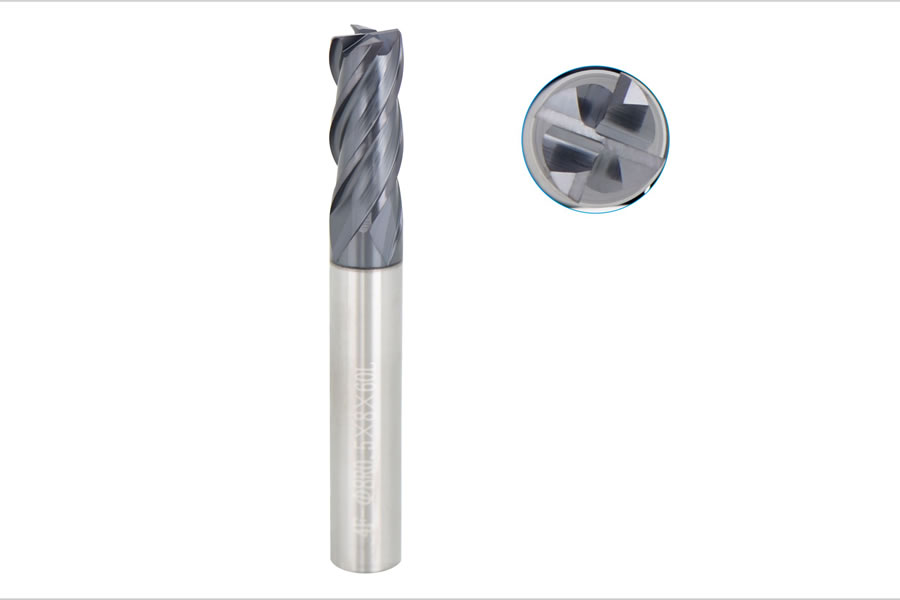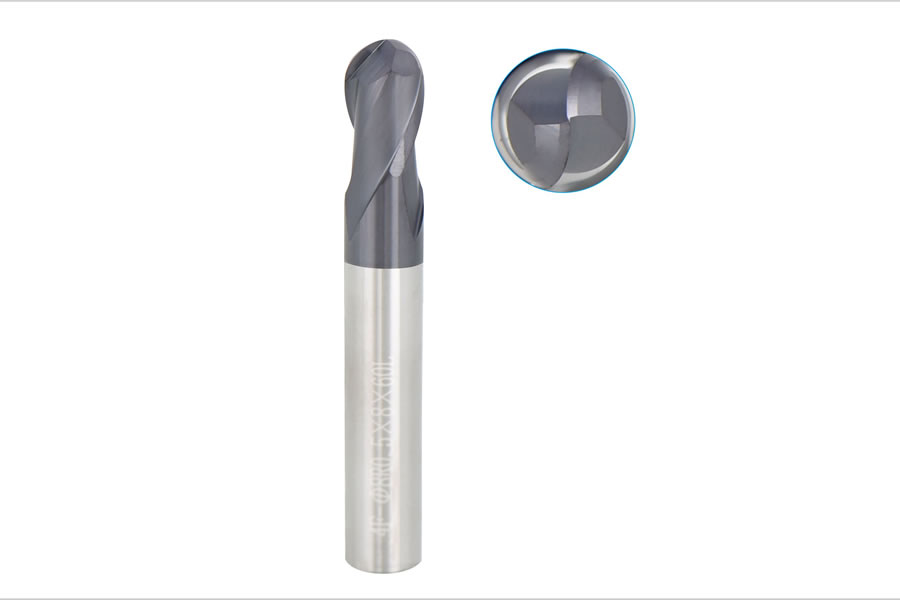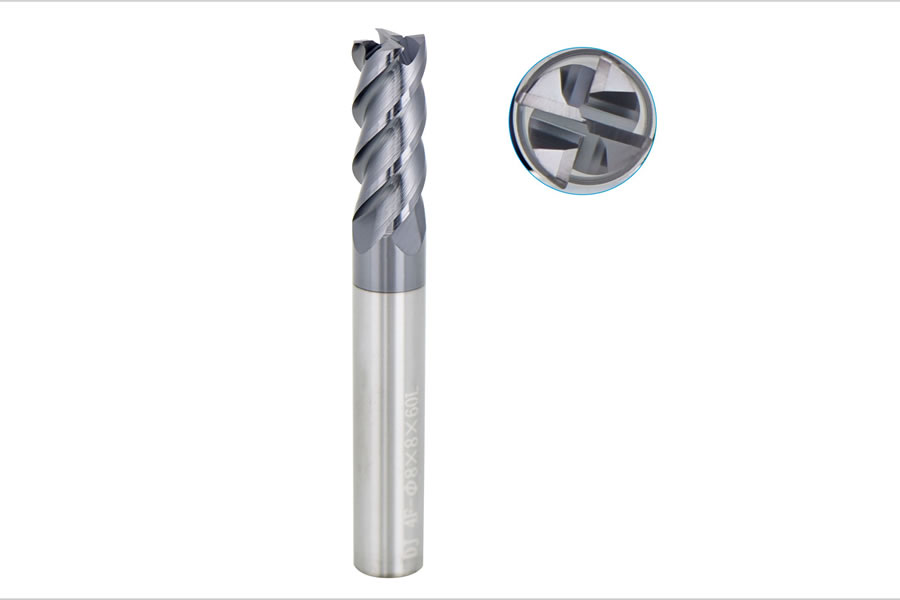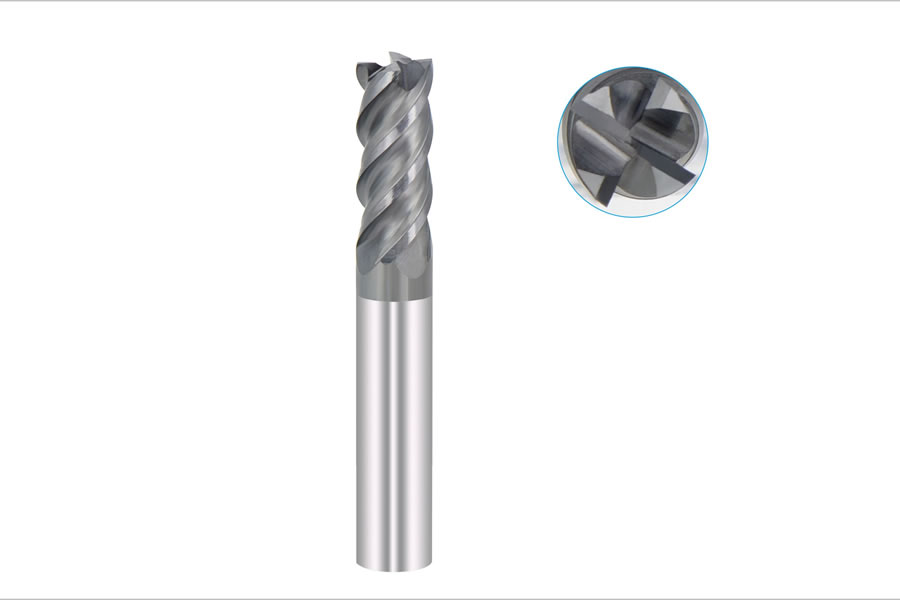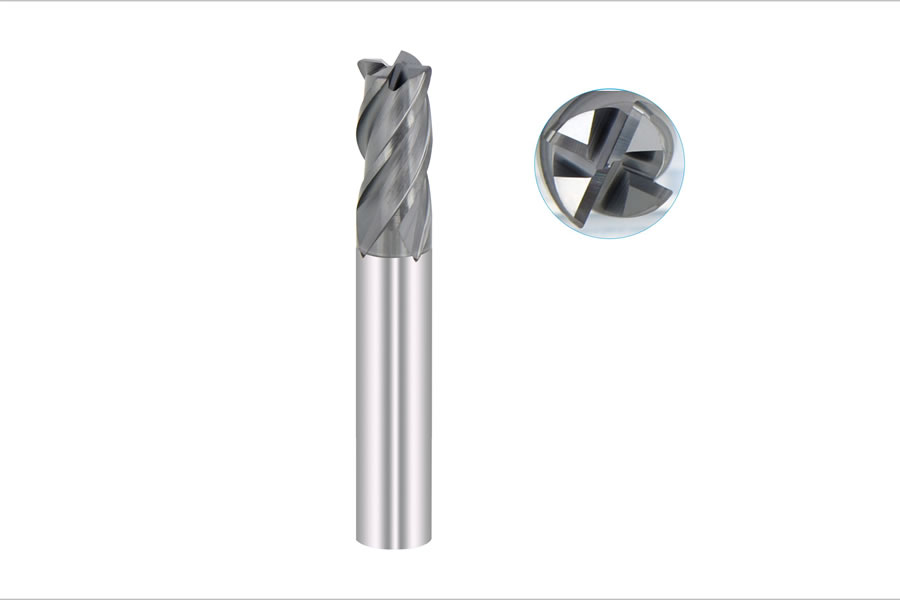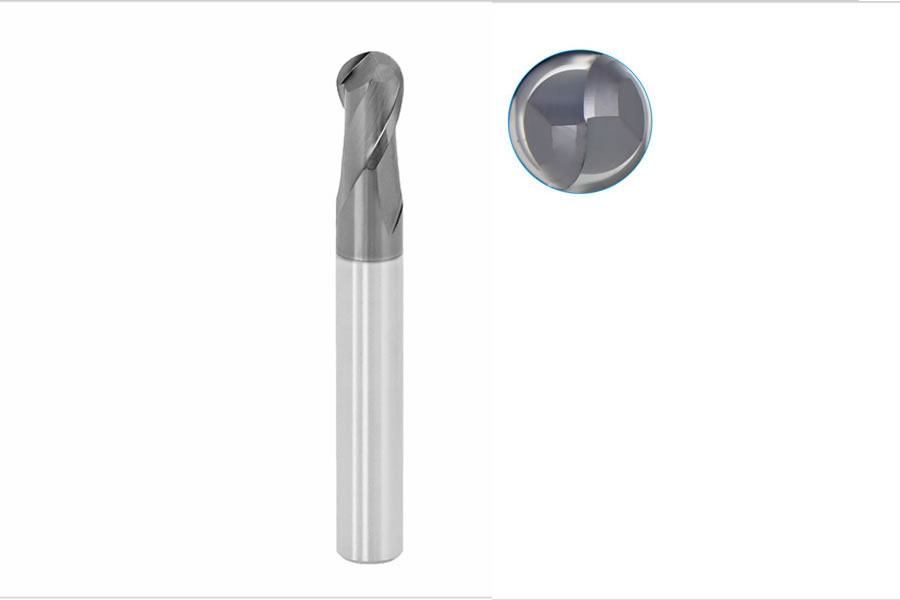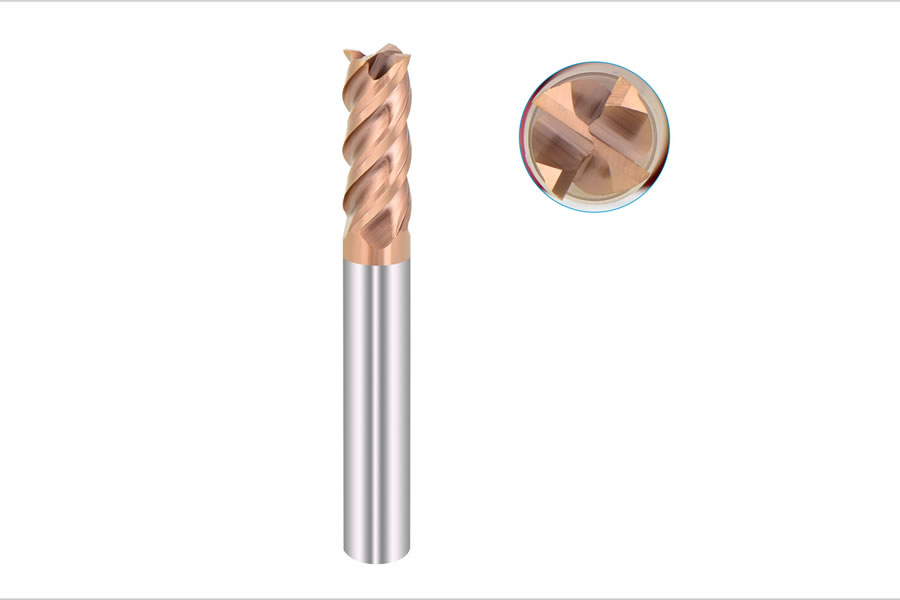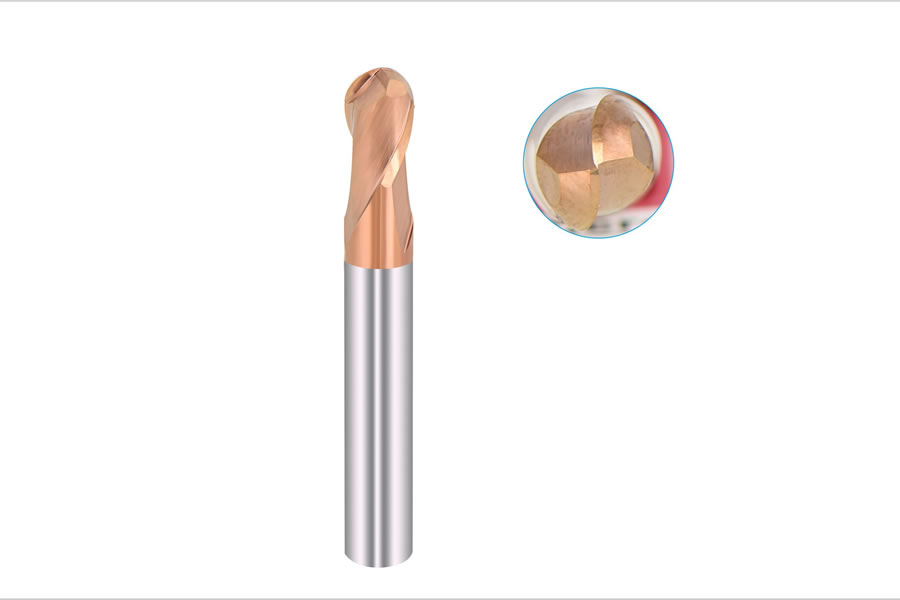
Selection of tool wear, tool life and cutting amount
Update time:2020-07-08 22:45:12Click on the number of times:1545 numberFontSize:T|T
1. Tool wear pattern and wear mechanism 1. Tool wear patterns (1) Wear of the rake face (crater crater wear) When cutting plastic materials, if the cutting speed and cutting thickness are larger, the chips will often wear a crescent cr
1. Tool wear pattern and wear mechanism
1. Tool wear patterns
(1) Wear of the rake face (crater crater wear) When cutting plastic materials, if the cutting speed and cutting thickness are larger, the chips will often wear a crescent crater on the rake face. This form of wear is called rake face wear . The part where the crescent crater appears is the part with the highest cutting temperature. There is a small edge between the crescent crater and the cutting edge. The crescent crater becomes larger as the tool wears. When the crescent crater expands to make the edge narrow, the strength of the cutting edge decreases, and it is easy to cause chipping. The amount of crescent wear is represented by its depth KT.
(2) Wear of the flank face Due to the strong friction between the flank face and the machining surface, the flank face close to the cutting edge will be gradually ground into a small prism with a zero rake angle. This form of wear is called the flank face Wear. When cutting cast iron and cutting plastic materials with a small cutting thickness and a low cutting speed, flank wear is the main form. The wear ribs on the flank surface are often uneven. The vicinity of the blade tip (zone C) has poor strength, poor heat dissipation conditions, and large wear; the middle zone (zone B) wears more uniformly, and its average wear width is expressed in VB .
(3) Boundary wear When cutting steel, deep grooves are often ground on the flank of the main cutting edge close to the workpiece skin and the secondary cutting edge close to the tool tip. This kind of wear is called boundary wear. The position of the groove is at the part where the main cutting edge and the surface to be processed of the workpiece and the auxiliary cutting edge and the processed surface are in contact.
2. Tool wear mechanism
(1) Hard point scratches Carbide, nitride, oxide and other hard points contained in the workpiece material and chip scraps, etc., scratched a groove on the surface of the tool, causing mechanical wear. Hard point scratches exist at various cutting speeds, and it is the main reason for the wear of low-speed cutting tools (such as broaches, die, etc.).
(2) During cold welding bonding cutting, due to the effect of high positive pressure and high temperature between the chip and the rake face, cold welding bonding occurs between the bottom material of the chip and the rake face to form a cold welding bond point. During the movement of the cutting edge of the tool, the particles on the surface of the tool material at the cold welding bonding point will be stuck away by the swarf, causing bond wear. The above-mentioned cold welding bond and wear mechanism also exists between the workpiece and the flank of the tool. At moderate to low cutting speeds, cold welding bonding is the main cause of wear.
(3) In the process of diffusion wear cutting, the flank of the tool is in contact with the processed surface, the rake face of the tool and the bottom surface of the chip. Due to the effect of high temperature and high pressure, the chemical elements in the tool material and the workpiece material diffuse together, making the tool material The chemical composition changes, and the wear resistance decreases, causing diffuse wear. For example, when cutting a steel workpiece with a cemented carbide tool, the cutting temperature exceeds 800°C, and the Co, C, W and other elements in the cemented carbide tool will diffuse into the chips and the workpiece. Due to the reduction of the Co element, the hard phase (WC, TiC) The bond strength decreases, resulting in faster tool wear. Diffusion wear occurs at high temperatures and increases with increasing temperature.
(4) Chemical wear Under a certain temperature, the tool material and the surrounding medium (such as oxygen in the air, extreme pressure additives sulfur and chlorine in the cutting fluid) play a chemical role, forming a lower hardness compound on the tool surface, which is easy The tool material is lost due to being scraped off by the chips and the workpiece. The resulting tool wear is called chemical wear. Chemical wear mainly occurs at higher cutting speeds.
2. Tool wear process and blunt standards
1. Tool wear process
The tool wear experiment results show that the tool wear process can be divided into three stages:
(1) The newly sharpened tool in the initial wear stage has just been put into use, the actual contact area between the flank face and the workpiece is very small, plus the microscopic unevenness of the flank face after the sharp edge grinding, the positive pressure on the unit contact area Very large, tool wear speed is extremely fast, this stage is called the initial wear stage of the tool. After the tool is sharpened, if the grinding surface can be ground with fine-grained whetstone, the initial wear of the tool can be significantly reduced.
(2) After the initial wear in the normal wear stage, the micro-rough surface of the tool flank has been smoothed, the contact area of the tool flank and the workpiece gradually increased, the pressure on the unit contact area gradually reduced, and the wear rate tended to slow. The tool wear at this stage is called the normal wear stage, and it is the effective working stage of the tool.
(3) Sharp wear stage When the tool wear amount increases to a certain limit, the cutting force and cutting temperature will increase sharply, and the tool wear speed will accelerate until the cutting ability is lost. This stage is called the sharp wear stage of the tool. Keeping the tool to continue to work in the stage of rapid wear and tear is an unacceptable thing. It not only can not guarantee the quality of the processing, but also consumes a large amount of tool material. If the blade cracks, the loss is even greater. The tool must be replaced before entering the stage of rapid wear.
2. Tool blunt standard
The tool wear can not be used to a certain limit, this wear limit is called the tool blunt standard. Because the flank of general tools will wear, and the measurement is more convenient, the international standard ISO uniformly stipulates that the width of the wear band measured on the flank surface at 1/2 back of the knife is used as the tool's blunt standard. For precision machining tools used in automated production, from the perspective of ensuring the dimensional accuracy of the workpiece, the radial wear of the tool is often used as a measure of the bluntness of the tool.
When formulating the grinding standards for cutting tools, it is necessary to give full consideration to the cutting capabilities of the cutting tools and to ensure the machining quality of the workpieces. The blunt grinding standard should be smaller when finishing, and the larger one when roughing; when the rigidity of the process system is poor, the blunt grinding standard should be smaller; when cutting difficult materials, the blunt grinding standard should also be smaller.
The international standard ISO recommends the blunt grinding standard for the life test of carbide turning tool tools. There are three options to choose from:
(1) VB=0.3mm;
(2) If the main flank face is irregularly worn, take VBmax=0.6mm;
(3) Amount of rake face wear, where f is the feed value in mm/r.
3. Tool life
1. Definition of tool life
The total cutting time experienced by the tool after sharpening from the beginning of cutting until the amount of wear reaches the blunt standard is called tool life and is expressed in terms of. A new knife is often scrapped many times before being scrapped. The tool life refers to the cutting time experienced between two sharpenings. The tool life times the number of sharpening times is the total tool life.
2. Empirical calculation formula of tool life
Cutting speed has the largest impact on tool life, followed by feed rate, and the least amount of back-feeding. This is consistent with their order of influence on cutting temperature, indicating that there is a close internal relationship between cutting temperature and tool life.
Cutting usage is closely related to tool life. If the tool life T is set high, the cutting amount will be low. Although the number of tool changes is small and the tool consumption is reduced, the cutting efficiency is reduced and the economic benefit may not be good; if the tool life T is set low, the cutting amount can be high, and the cutting efficiency It is improved, but the number of tool changes is large, the tool consumption becomes large, the adjustment of the tool takes a long time, and the economic benefit may not be good. In production, there are two different principles for determining the tool life. The tool life determined according to the principle of least time per piece is called the maximum productivity tool life; the tool life determined according to the principle of the lowest cost per piece is called the minimum cost tool life.
In general, the minimum cost tool life should be used. When the production task is urgent or the beat imbalance occurs in production, the tool life with the highest productivity can be selected.
When formulating tool life, the following points should also be specifically considered:
1) When the tool structure is complicated and the cost of manufacturing and sharpening is high, the tool life should be specified higher.
2) The turning tool on the multi-tool lathe combines the drill bit, tap and milling cutter on the machine tool, the automatic machine and the automatic line tool. Because the adjustment is complicated, the tool life should be specified higher.
3) When the production of a process becomes a bottleneck on the production line, the tool life should be set lower, so that a larger amount of cutting can be selected to speed up the production cycle of the process; when the production cost per unit time of a process is higher, the tool life It should be specified lower, so that a larger amount of cutting can be selected to shorten the processing time.
4) When finishing large workpieces, the tool life should be specified higher, at least to ensure that the tool is not changed in one pass.
4. Tool breakage and tool status monitoring
In the cutting process, the tool sometimes does not undergo normal wear and tear, but is suddenly damaged in a short time. This situation is called tool damage. Wear is a gradual development process, and damage is sudden. The suddenness of damage can easily cause great harm and economic loss in the production process.
1. Tool breakage form
The damage form of cutter is divided into brittle damage and plastic damage.
(1) Brittle damage
When cutting carbide tools and ceramic tools, under the action of mechanical stress and thermal stress, the following types of damage often occur:
1) The chipped cutting edge produces a small gap. In the continued cutting, the gap will continue to expand, resulting in greater damage. Such damage often occurs when cutting with ceramic tools and intermittent cutting with cemented carbide tools.
2) Small pieces or large pieces of broken cutting edge can't continue cutting. Such breakage often occurs when using carbide tools and ceramic tools for intermittent cutting.
3) Peeling debris appears on the front and back flank of the cutter, often peeling off together with the cutting edge, and sometimes peeling off at a short distance from the cutting edge. Such damage often occurs in end milling of ceramic tools.
4) Crack breakage A type of breakage caused by fatigue due to intermittent cutting for a long time. Both thermal and mechanical shocks can cause cracks, and the continuous expansion of the cracks will cause the cutting edge to crack or break.
(2) Plastic damage
In the contact surface between the cutting face of the tool and the chip, and the back face and the workpiece, due to the effect of excessive temperature and pressure, the surface material of the tool will lose its cutting ability due to plastic flow, which is the plastic damage of the tool. The ability to resist plastic damage depends on the hardness and heat resistance of the tool material. Cemented carbide and ceramics have good heat resistance and are generally not prone to such damage. In contrast, high-speed steel has poor heat resistance and is prone to plastic damage.
2. Preventive measures for tool breakage
(1) Brittle damage
When cutting carbide tools and ceramic tools, under the action of mechanical stress and thermal stress, the following types of damage often occur:
1) The chipped cutting edge produces a small gap. In the continued cutting, the gap will continue to expand, resulting in greater damage. Such damage often occurs when cutting with ceramic tools and intermittent cutting with cemented carbide tools.
2) Small pieces or large pieces of broken cutting edge can't continue cutting. Such breakage often occurs when using carbide tools and ceramic tools for intermittent cutting.
3) Peeling debris appears on the front and back flank of the cutter, often peeling off together with the cutting edge, and sometimes peeling off at a short distance from the cutting edge. Such damage often occurs in end milling of ceramic tools.
4) Crack breakage A type of breakage caused by fatigue due to intermittent cutting for a long time. Both thermal and mechanical shocks can cause cracks, and the continuous expansion of the cracks will cause the cutting edge to crack or break.
(2) Plastic damage
In the contact surface between the cutting face of the tool and the chip, and the back face and the workpiece, due to the effect of excessive temperature and pressure, the surface material of the tool will lose its cutting ability due to plastic flow, which is the plastic damage of the tool. The ability to resist plastic damage depends on the hardness and heat resistance of the tool material. Cemented carbide and ceramics have good heat resistance and are generally not prone to such damage. In contrast, high-speed steel has poor heat resistance and is prone to plastic damage.
2. Preventive measures for tool breakage
(1) Reasonable selection of tool materials For cutting tools, the tool materials should have high toughness.
(2) Reasonable selection of tool geometric parameters By selecting appropriate geometric parameters, the cutting edge and tool tip have better strength. Grinding negative chamfer on the cutting edge is an effective measure to prevent chipping.
(3) Ensure the quality of the cutting edge of the cutting tool. The cutting edge should be straight and smooth, and there should be no gaps. The cutting edge and the cutting edge are not allowed to burn.
(4) Reasonably choose the cutting amount to prevent excessive cutting force and excessive cutting temperature.
(5) The process system should have better rigidity to prevent damage to the tool due to strong vibration.
(6) Real-time monitoring of tool status The methods of monitoring tool status include force measurement method, main motor current measurement method and acoustic emission method.
V. Selection of cutting dosage
1. Selection principle of cutting amount
The choice of cutting dosage has an important impact on production efficiency, processing cost and processing quality. The so-called reasonable cutting amount refers to the cutting amount that can achieve higher production efficiency and lower cost under the premise of ensuring the processing quality. The main conditions that restrict the choice of cutting amount are: the processing requirements of the workpiece, including the processing quality requirements and production efficiency requirements; the cutting performance of the tool material; the performance of the machine tool, including the dynamic characteristics (power, torque) and motion characteristics; the tool life requirements.
(1) The relationship between cutting consumption, production efficiency and tool life
The cutting efficiency of the machine tool can be expressed by the volume of material removed per unit time (mm3/min). The three elements of the cutting amount are directly proportional to each other. The weight of the three factors on the cutting efficiency of the machine tool is exactly the same. From the perspective of improving production efficiency, doubling any of the three factors of cutting consumption will double the cutting efficiency of the machine tool, but the impact of doubling and doubling on tool life is completely different. Among the three factors of cutting consumption, the biggest influence on the tool life is the amount of back-feeding, followed by the feed amount, and then the cutting speed; under the condition of maintaining the life of the tool, the production of increasing the back-feeding amount is higher than the increase in feed. High efficiency, higher production efficiency than increasing cutting speed.
(2) Selection principle of cutting amount
The basic principle for selecting the cutting amount is: first select the largest possible amount of back-feeding knife; secondly, according to the constraints of the machine tool feed mechanism strength, tool bar stiffness (when roughing) or the roughness requirements of the processed surface (when finishing) , Select the largest possible feed amount f; finally, check it according to the "Cutting Quantity Manual" or calculate it according to the formula to determine the cutting speed.
(3) Selection of the three elements of cutting consumption
1) The amount of back-eating knife is determined according to the processing allowance. When roughing, as long as the power of the machine tool permits, the roughing allowance should be removed in one pass. In the following situations, the cutting can be performed several times: ① The machining allowance is too large, resulting in insufficient machine power or insufficient tool strength; ② Insufficient rigidity of the process system; ③ Intermittent cutting Cutting forged castings with hard skin on the surface or cutting materials with more severe cold-hardening tendency (for example
1. Tool wear patterns
(1) Wear of the rake face (crater crater wear) When cutting plastic materials, if the cutting speed and cutting thickness are larger, the chips will often wear a crescent crater on the rake face. This form of wear is called rake face wear . The part where the crescent crater appears is the part with the highest cutting temperature. There is a small edge between the crescent crater and the cutting edge. The crescent crater becomes larger as the tool wears. When the crescent crater expands to make the edge narrow, the strength of the cutting edge decreases, and it is easy to cause chipping. The amount of crescent wear is represented by its depth KT.
(2) Wear of the flank face Due to the strong friction between the flank face and the machining surface, the flank face close to the cutting edge will be gradually ground into a small prism with a zero rake angle. This form of wear is called the flank face Wear. When cutting cast iron and cutting plastic materials with a small cutting thickness and a low cutting speed, flank wear is the main form. The wear ribs on the flank surface are often uneven. The vicinity of the blade tip (zone C) has poor strength, poor heat dissipation conditions, and large wear; the middle zone (zone B) wears more uniformly, and its average wear width is expressed in VB .
(3) Boundary wear When cutting steel, deep grooves are often ground on the flank of the main cutting edge close to the workpiece skin and the secondary cutting edge close to the tool tip. This kind of wear is called boundary wear. The position of the groove is at the part where the main cutting edge and the surface to be processed of the workpiece and the auxiliary cutting edge and the processed surface are in contact.
2. Tool wear mechanism
(1) Hard point scratches Carbide, nitride, oxide and other hard points contained in the workpiece material and chip scraps, etc., scratched a groove on the surface of the tool, causing mechanical wear. Hard point scratches exist at various cutting speeds, and it is the main reason for the wear of low-speed cutting tools (such as broaches, die, etc.).
(2) During cold welding bonding cutting, due to the effect of high positive pressure and high temperature between the chip and the rake face, cold welding bonding occurs between the bottom material of the chip and the rake face to form a cold welding bond point. During the movement of the cutting edge of the tool, the particles on the surface of the tool material at the cold welding bonding point will be stuck away by the swarf, causing bond wear. The above-mentioned cold welding bond and wear mechanism also exists between the workpiece and the flank of the tool. At moderate to low cutting speeds, cold welding bonding is the main cause of wear.
(3) In the process of diffusion wear cutting, the flank of the tool is in contact with the processed surface, the rake face of the tool and the bottom surface of the chip. Due to the effect of high temperature and high pressure, the chemical elements in the tool material and the workpiece material diffuse together, making the tool material The chemical composition changes, and the wear resistance decreases, causing diffuse wear. For example, when cutting a steel workpiece with a cemented carbide tool, the cutting temperature exceeds 800°C, and the Co, C, W and other elements in the cemented carbide tool will diffuse into the chips and the workpiece. Due to the reduction of the Co element, the hard phase (WC, TiC) The bond strength decreases, resulting in faster tool wear. Diffusion wear occurs at high temperatures and increases with increasing temperature.
(4) Chemical wear Under a certain temperature, the tool material and the surrounding medium (such as oxygen in the air, extreme pressure additives sulfur and chlorine in the cutting fluid) play a chemical role, forming a lower hardness compound on the tool surface, which is easy The tool material is lost due to being scraped off by the chips and the workpiece. The resulting tool wear is called chemical wear. Chemical wear mainly occurs at higher cutting speeds.
2. Tool wear process and blunt standards
1. Tool wear process
The tool wear experiment results show that the tool wear process can be divided into three stages:
(1) The newly sharpened tool in the initial wear stage has just been put into use, the actual contact area between the flank face and the workpiece is very small, plus the microscopic unevenness of the flank face after the sharp edge grinding, the positive pressure on the unit contact area Very large, tool wear speed is extremely fast, this stage is called the initial wear stage of the tool. After the tool is sharpened, if the grinding surface can be ground with fine-grained whetstone, the initial wear of the tool can be significantly reduced.
(2) After the initial wear in the normal wear stage, the micro-rough surface of the tool flank has been smoothed, the contact area of the tool flank and the workpiece gradually increased, the pressure on the unit contact area gradually reduced, and the wear rate tended to slow. The tool wear at this stage is called the normal wear stage, and it is the effective working stage of the tool.
(3) Sharp wear stage When the tool wear amount increases to a certain limit, the cutting force and cutting temperature will increase sharply, and the tool wear speed will accelerate until the cutting ability is lost. This stage is called the sharp wear stage of the tool. Keeping the tool to continue to work in the stage of rapid wear and tear is an unacceptable thing. It not only can not guarantee the quality of the processing, but also consumes a large amount of tool material. If the blade cracks, the loss is even greater. The tool must be replaced before entering the stage of rapid wear.
2. Tool blunt standard
The tool wear can not be used to a certain limit, this wear limit is called the tool blunt standard. Because the flank of general tools will wear, and the measurement is more convenient, the international standard ISO uniformly stipulates that the width of the wear band measured on the flank surface at 1/2 back of the knife is used as the tool's blunt standard. For precision machining tools used in automated production, from the perspective of ensuring the dimensional accuracy of the workpiece, the radial wear of the tool is often used as a measure of the bluntness of the tool.
When formulating the grinding standards for cutting tools, it is necessary to give full consideration to the cutting capabilities of the cutting tools and to ensure the machining quality of the workpieces. The blunt grinding standard should be smaller when finishing, and the larger one when roughing; when the rigidity of the process system is poor, the blunt grinding standard should be smaller; when cutting difficult materials, the blunt grinding standard should also be smaller.
The international standard ISO recommends the blunt grinding standard for the life test of carbide turning tool tools. There are three options to choose from:
(1) VB=0.3mm;
(2) If the main flank face is irregularly worn, take VBmax=0.6mm;
(3) Amount of rake face wear, where f is the feed value in mm/r.
3. Tool life
1. Definition of tool life
The total cutting time experienced by the tool after sharpening from the beginning of cutting until the amount of wear reaches the blunt standard is called tool life and is expressed in terms of. A new knife is often scrapped many times before being scrapped. The tool life refers to the cutting time experienced between two sharpenings. The tool life times the number of sharpening times is the total tool life.
2. Empirical calculation formula of tool life
Cutting speed has the largest impact on tool life, followed by feed rate, and the least amount of back-feeding. This is consistent with their order of influence on cutting temperature, indicating that there is a close internal relationship between cutting temperature and tool life.
Cutting usage is closely related to tool life. If the tool life T is set high, the cutting amount will be low. Although the number of tool changes is small and the tool consumption is reduced, the cutting efficiency is reduced and the economic benefit may not be good; if the tool life T is set low, the cutting amount can be high, and the cutting efficiency It is improved, but the number of tool changes is large, the tool consumption becomes large, the adjustment of the tool takes a long time, and the economic benefit may not be good. In production, there are two different principles for determining the tool life. The tool life determined according to the principle of least time per piece is called the maximum productivity tool life; the tool life determined according to the principle of the lowest cost per piece is called the minimum cost tool life.
In general, the minimum cost tool life should be used. When the production task is urgent or the beat imbalance occurs in production, the tool life with the highest productivity can be selected.
When formulating tool life, the following points should also be specifically considered:
1) When the tool structure is complicated and the cost of manufacturing and sharpening is high, the tool life should be specified higher.
2) The turning tool on the multi-tool lathe combines the drill bit, tap and milling cutter on the machine tool, the automatic machine and the automatic line tool. Because the adjustment is complicated, the tool life should be specified higher.
3) When the production of a process becomes a bottleneck on the production line, the tool life should be set lower, so that a larger amount of cutting can be selected to speed up the production cycle of the process; when the production cost per unit time of a process is higher, the tool life It should be specified lower, so that a larger amount of cutting can be selected to shorten the processing time.
4) When finishing large workpieces, the tool life should be specified higher, at least to ensure that the tool is not changed in one pass.
4. Tool breakage and tool status monitoring
In the cutting process, the tool sometimes does not undergo normal wear and tear, but is suddenly damaged in a short time. This situation is called tool damage. Wear is a gradual development process, and damage is sudden. The suddenness of damage can easily cause great harm and economic loss in the production process.
1. Tool breakage form
The damage form of cutter is divided into brittle damage and plastic damage.
(1) Brittle damage
When cutting carbide tools and ceramic tools, under the action of mechanical stress and thermal stress, the following types of damage often occur:
1) The chipped cutting edge produces a small gap. In the continued cutting, the gap will continue to expand, resulting in greater damage. Such damage often occurs when cutting with ceramic tools and intermittent cutting with cemented carbide tools.
2) Small pieces or large pieces of broken cutting edge can't continue cutting. Such breakage often occurs when using carbide tools and ceramic tools for intermittent cutting.
3) Peeling debris appears on the front and back flank of the cutter, often peeling off together with the cutting edge, and sometimes peeling off at a short distance from the cutting edge. Such damage often occurs in end milling of ceramic tools.
4) Crack breakage A type of breakage caused by fatigue due to intermittent cutting for a long time. Both thermal and mechanical shocks can cause cracks, and the continuous expansion of the cracks will cause the cutting edge to crack or break.
(2) Plastic damage
In the contact surface between the cutting face of the tool and the chip, and the back face and the workpiece, due to the effect of excessive temperature and pressure, the surface material of the tool will lose its cutting ability due to plastic flow, which is the plastic damage of the tool. The ability to resist plastic damage depends on the hardness and heat resistance of the tool material. Cemented carbide and ceramics have good heat resistance and are generally not prone to such damage. In contrast, high-speed steel has poor heat resistance and is prone to plastic damage.
2. Preventive measures for tool breakage
(1) Brittle damage
When cutting carbide tools and ceramic tools, under the action of mechanical stress and thermal stress, the following types of damage often occur:
1) The chipped cutting edge produces a small gap. In the continued cutting, the gap will continue to expand, resulting in greater damage. Such damage often occurs when cutting with ceramic tools and intermittent cutting with cemented carbide tools.
2) Small pieces or large pieces of broken cutting edge can't continue cutting. Such breakage often occurs when using carbide tools and ceramic tools for intermittent cutting.
3) Peeling debris appears on the front and back flank of the cutter, often peeling off together with the cutting edge, and sometimes peeling off at a short distance from the cutting edge. Such damage often occurs in end milling of ceramic tools.
4) Crack breakage A type of breakage caused by fatigue due to intermittent cutting for a long time. Both thermal and mechanical shocks can cause cracks, and the continuous expansion of the cracks will cause the cutting edge to crack or break.
(2) Plastic damage
In the contact surface between the cutting face of the tool and the chip, and the back face and the workpiece, due to the effect of excessive temperature and pressure, the surface material of the tool will lose its cutting ability due to plastic flow, which is the plastic damage of the tool. The ability to resist plastic damage depends on the hardness and heat resistance of the tool material. Cemented carbide and ceramics have good heat resistance and are generally not prone to such damage. In contrast, high-speed steel has poor heat resistance and is prone to plastic damage.
2. Preventive measures for tool breakage
(1) Reasonable selection of tool materials For cutting tools, the tool materials should have high toughness.
(2) Reasonable selection of tool geometric parameters By selecting appropriate geometric parameters, the cutting edge and tool tip have better strength. Grinding negative chamfer on the cutting edge is an effective measure to prevent chipping.
(3) Ensure the quality of the cutting edge of the cutting tool. The cutting edge should be straight and smooth, and there should be no gaps. The cutting edge and the cutting edge are not allowed to burn.
(4) Reasonably choose the cutting amount to prevent excessive cutting force and excessive cutting temperature.
(5) The process system should have better rigidity to prevent damage to the tool due to strong vibration.
(6) Real-time monitoring of tool status The methods of monitoring tool status include force measurement method, main motor current measurement method and acoustic emission method.
V. Selection of cutting dosage
1. Selection principle of cutting amount
The choice of cutting dosage has an important impact on production efficiency, processing cost and processing quality. The so-called reasonable cutting amount refers to the cutting amount that can achieve higher production efficiency and lower cost under the premise of ensuring the processing quality. The main conditions that restrict the choice of cutting amount are: the processing requirements of the workpiece, including the processing quality requirements and production efficiency requirements; the cutting performance of the tool material; the performance of the machine tool, including the dynamic characteristics (power, torque) and motion characteristics; the tool life requirements.
(1) The relationship between cutting consumption, production efficiency and tool life
The cutting efficiency of the machine tool can be expressed by the volume of material removed per unit time (mm3/min). The three elements of the cutting amount are directly proportional to each other. The weight of the three factors on the cutting efficiency of the machine tool is exactly the same. From the perspective of improving production efficiency, doubling any of the three factors of cutting consumption will double the cutting efficiency of the machine tool, but the impact of doubling and doubling on tool life is completely different. Among the three factors of cutting consumption, the biggest influence on the tool life is the amount of back-feeding, followed by the feed amount, and then the cutting speed; under the condition of maintaining the life of the tool, the production of increasing the back-feeding amount is higher than the increase in feed. High efficiency, higher production efficiency than increasing cutting speed.
(2) Selection principle of cutting amount
The basic principle for selecting the cutting amount is: first select the largest possible amount of back-feeding knife; secondly, according to the constraints of the machine tool feed mechanism strength, tool bar stiffness (when roughing) or the roughness requirements of the processed surface (when finishing) , Select the largest possible feed amount f; finally, check it according to the "Cutting Quantity Manual" or calculate it according to the formula to determine the cutting speed.
(3) Selection of the three elements of cutting consumption
1) The amount of back-eating knife is determined according to the processing allowance. When roughing, as long as the power of the machine tool permits, the roughing allowance should be removed in one pass. In the following situations, the cutting can be performed several times: ① The machining allowance is too large, resulting in insufficient machine power or insufficient tool strength; ② Insufficient rigidity of the process system; ③ Intermittent cutting Cutting forged castings with hard skin on the surface or cutting materials with more severe cold-hardening tendency (for example
(editor:www.dongjiesharp.com)
- Last one:no more
- Next:刀具為什么要故意進行“鈍化”
New Product Recommendation
